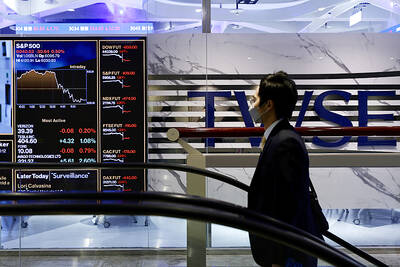Handset camera lens supplier Largan Precision Co (大立光) yesterday gave a positive outlook for this quarter, saying business would fare stronger than last quarter, but unsatisfactory yield rates are capping its manufacturing capacity.
The Taichung-based company, which counts Apple Inc and Xiaomi Corp (小米) among its customers, said shipments are accelerating this month and beyond, backed by a continued migration of customers to high-end devices.
Lenses with 10 megapixels accounted for about 50 percent of its shipments last quarter, 8 megapixels contributed 30 percent and 5 megapixels the remaining 20 percent, Largan data showed.
As a growing number of handset brands introduce dual-camera lenses for their new-generation models, the trend might benefit Largan, Lin said.
Largan last week reported revenue of NT$4.95 billion (US$156 million) for last month, its highest monthly figure since November last year, with analysts staying positive on the company’s near-term outlook as the handset lens has become a seller’s market, in which Largan dominates.
The adoption of high-end devices benefited Largan’s gross margin, which rose to a record 68 percent last quarter, from 66.4 percent in the previous quarter, special assistant to the chief executive Josephine Huang (黃印嘉) said.
The continued decline in voice coil motor (VCM) business lent support to the profit margin because it generates thin profits, Huang said.
While Largan refused to comment on specific customers, better-than-expected iPhone 7 sales in the wake of Samsung Electronics Co’s troubled Galaxy Note 7 boosted Largan orders and profitability.
In the July-to-September quarter, Largan reported a net income of NT$6.96 billion, while revenue totaled NT$14.31 billion, Huang said.
The results represented a retreat of 15.9 percent and 11 percent from the same period last year because the company took a hit from foreign-exchange losses that eroded profit by NT$420 million, in addition to the decline in the VCM business, Huang said.
The New Taiwan dollar gained 3.87 percent against the US dollar in the third quarter, but depreciated 7.31 percent from a year earlier, allowing Largan and other exporters to reap a windfall.
“A strong NT dollar is unfavorable for Largan, but other things matter too,” Huang said.
Yield rates remain an issue that has constrained revenue growth, Lin said.
“Granted demand appears stronger this quarter, but the room for capacity increase is limited unless we can push up production yield rates,” Lin said.
The increasing variety in product models is raising difficulty for yield improvement unless the company can find solutions and upgrade its technology, Lin said.
Regarding the issue of capacity constraints, Deutsche Bank AG said in a note ahead of yesterday’s earnings conference that all Largan can do to increase its monthly output is “streamline production flows” in addition to improving yields for new products.
That is because Largan’s new Taichung factory is unlikely to be ready for mass production until the third quarter of next year, Deutsche Bank said.
Lin said the construction of the new and much larger manufacturing facility is expected to be completed by the end of second quarter next year and start mass production the following quarter.
The company is also taking part in major Internet of Vehicle development projects, but they are unlikely to generate significant earnings contributions in the foreseeable future due to the small volume, he said.
Largan shares fell 1.84 percent on the Taiwan Stock Exchange yesterday amid broad market weakness.

A wave of stop-loss selling and panic selling hit Taiwan's stock market at its opening today, with the weighted index plunging 2,086 points — a drop of more than 9.7 percent — marking the largest intraday point and percentage loss on record. The index bottomed out at 19,212.02, while futures were locked limit-down, with more than 1,000 stocks hitting their daily drop limit. Three heavyweight stocks — Taiwan Semiconductor Manufacturing Co (TSMC, 台積電), Hon Hai Precision Industry Co (Foxconn, 鴻海精密) and MediaTek (聯發科) — hit their limit-down prices as soon as the market opened, falling to NT$848 (US$25.54), NT$138.5 and NT$1,295 respectively. TSMC's

SELL-OFF: Investors expect tariff-driven volatility as the local boarse reopens today, while analysts say government support and solid fundamentals would steady sentiment Local investors are bracing for a sharp market downturn today as the nation’s financial markets resume trading following a two-day closure for national holidays before the weekend, with sentiment rattled by US President Donald Trump’s sweeping tariff announcement. Trump’s unveiling of new “reciprocal tariffs” on Wednesday triggered a sell-off in global markets, with the FTSE Taiwan Index Futures — a benchmark for Taiwanese equities traded in Singapore — tumbling 9.2 percent over the past two sessions. Meanwhile, the American depositary receipts (ADRs) of Taiwan Semiconductor Manufacturing Co (TSMC, 台積電), the most heavily weighted stock on the TAIEX, plunged 13.8 percent in

In a small town in Paraguay, a showdown is brewing between traditional producers of yerba mate, a bitter herbal tea popular across South America, and miners of a shinier treasure: gold. A rush for the precious metal is pitting mate growers and indigenous groups against the expanding operations of small-scale miners who, until recently, were their neighbors, not nemeses. “They [the miners] have destroyed everything... The canals, springs, swamps,” said Vidal Britez, president of the Yerba Mate Producers’ Association of the town of Paso Yobai, about 210km east of capital Asuncion. “You can see the pollution from the dead fish.

ASML Holding NV, the sole producer of the most advanced machines used in semiconductor manufacturing, said geopolitical tensions are harming innovation a day after US President Donald Trump levied massive tariffs that promise to disrupt trade flows across the entire world. “Our industry has been built basically on the ability of people to work together, to innovate together,” ASML chief executive officer Christophe Fouquet said in a recorded message at a Thursday industry event in the Netherlands. Export controls and increasing geopolitical tensions challenge that collaboration, he said, without specifically addressing the new US tariffs. Tech executives in the EU, which is